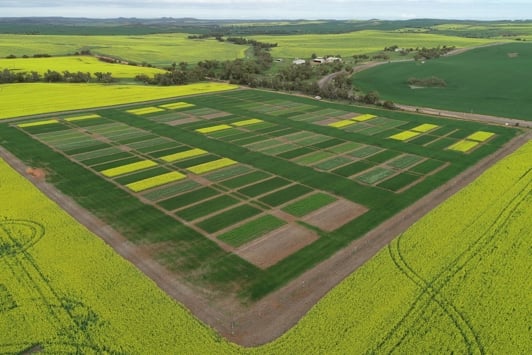Use the calculator to:
- evaluate information gathered from Dynamic Crop Sequence trials carried out by the department and co-funded by the department and GRDC. Trials were conducted at Katanning (Year 1 = 2008) and Wongan Hills (Year 1 = 2009)
- compare the results with experimental data collected in Western Australia since 1974.
- compare growers’ experiences to experimental data.
- quickly compare gross margins for 3-year crop sequences.
The WA Crop sequence calculator was developed by the Department of Primary Industries and Regional Development (DPIRD) and co-funded by DPIRD and the Grain Research Development Corporation. It is loosely based on crop sequence calculators developed by the United States Department of Agriculture and the Agriculture Research Service, Northern Great Plains Research Laboratory Mandan, North Dakota, USA.
- Select either the Katanning or Wongan Hills DCS trial.
- For each year, select the crop type you wish to consider. This will automatically return the grain yields, costs and returns obtained for the DCS experiment.
- You can choose to enter your own information as a % of experimental yield or t/ha.
- Similarly, you can change the costs and grain prices to suit your situation. Gross margins will automatically update.
- Below the financial summary are graphs using the historical data set to compare crop sequences to wheat after wheat. Change the crop selected in Year 2 to alter the sequence.
The histogram shows how often the difference in yield of the selected crop sequence and wheat after wheat falls in selected ranges. The scatter plot shows a marker (in green) for every trial where the selected crop sequence is compared to wheat after wheat. A yellow marker indicates the data for either the Katanning or Wongan Hills DCS trial. Markers above the 1:1 line are higher yielding than wheat after wheat.
References
Mark Seymour, John A. Kirkegaard, Mark B. Peoples, Peter F. White, and Robert J. French. 2012, Break-crop benefits to wheat in Western Australia – insights from over three decades of research, Crop and Pasture Science 63, 1-16.
Raj S. Malik, Mark Seymour, Robert J. French, John A. Kirkegaard, Roger A. Lawes and Mark A. Liebig. 2015. Dynamic crop sequencing in Western Australian cropping systems
R. J. French, R. S. Malik, and M. Seymour. 2015. Crop-sequence effects on productivity in a wheat-based cropping system at Wongan Hills, Western Australia, Crop and Pasture Science 66 (6) 580-593
Drew, J, Grima, R, French, B, Malik, R, Seymour, M, Zaicou-Kunesch, C, McDonald, G, Nicholas, B, van Gool, D, Fisher, J, Tozer, P, Abrecht, D, Robertson, M, Weeks, C, O'Conner, M, Newman, P, Clarke, M, Blake, A, MacAulay, G, Jayasena, V, Nasar-Abbas, S M, Cato, L, Loughman, R, and Quail, K. (2011), Crop Updates 2011 - Farming Systems. Conference Proceeding. Department of Primary Industries and Regional Development, South Perth.
Contact us
-
Mark SeymourPrincipal Research Scientist, Broadacre Systems

